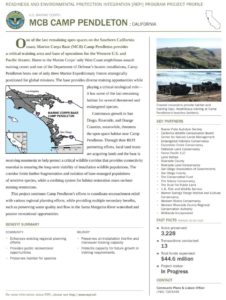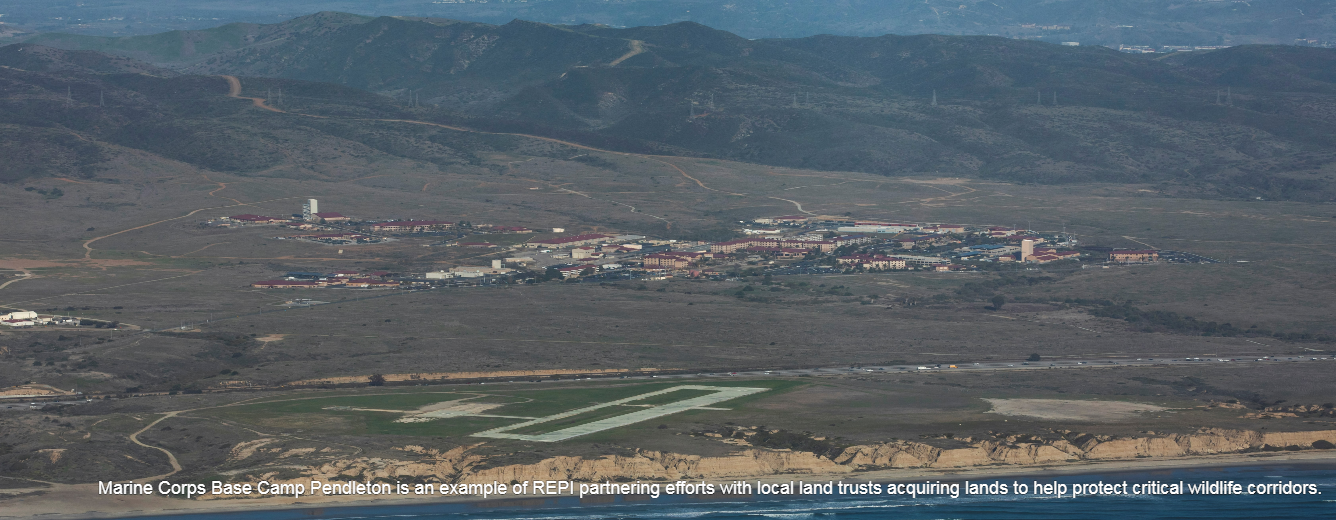Our country needs a military force equipped and ready to deploy worldwide on short notice. Thousands of square miles of land and airspace are essential to our nation’s combat readiness. Many military installations in the United States were initially established in remote areas where the nearest off-post communities were several miles from the installation “front gate.” The military was able to conduct training exercises and weapons testing without disturbing residents or businesses.
Several factors have caused this situation to change. The population of many communities surrounding military installations has increased, vacant land has become residential developments, several military installations have closed, manpower and resources from multiple installations have been consolidated, and military tactics and capabilities changed. Call it sprawl, encroachment, or progress, but the military has found its essential training requirements in conflict with activities beyond the fence line. This was the basis for the Department of Defense’s (DoD) Readiness and Environmental Protection Integration (REPI) program, a collaborative partnership between federal, state, and local governments and non-profit organizations.
1. What is REPI?
REPI is a DoD program to prevent or minimize the impact of encroachment from adversely affecting the military’s ability to use land for testing, training, or
Congress has appropriated funds to pay for the effort and conservation organizations and local communities have provided additional funds. Leveraging DoD appropriations with partnership contributions is a hallmark of the REPI program. The funds have been used to purchase land in fee or establish legally binding easements on use of critical property.
2. What is the Sentinel Landscape Program?
The Sentinel Landscape Program takes REPI to a whole new level by establishing partnerships between major land management agencies, state, and local governments, private landowners, and non-profit organizations. By working together, participants form a coalition to identify and implement land management practices that extend beyond land ownership boundaries. The purpose of the program is to strengthen military readiness, bolster agricultural productivity, preserve natural resources, and increase access to recreation.
From its inception in 2013 until 2019, $141 million in DoD funds have been leveraged with $223 million in USDA funds, $41 million in Department of the Interior funds, $169 million in state funds, $15 million in local funds, and $80 million in private funds to support partnership projects. These contributions have protected over 467,000 acres of land and implemented sustainable management practices on 2.3 million acres around high-value military testing and training areas. Successful Sentinel Landscape programs have been established at Avon Park Air Force Range, Florida, Camp Ripley, Minnesota, Eastern North Carolina, and other areas.
3. What is REPI Resilience?
“Military Installation Resilience” carries a specific legal definition: “The capability of a military installation to avoid, prepare for, minimize the effect of, adapt to, and recover from extreme weather events, or from anticipated or unanticipated changes in environmental conditions, that do, or have the potential to, adversely affect the military installation or essential transportation, logistical, or other necessary resources outside of the military installation that are necessary in order to maintain, improve, or rapidly reestablish installation mission assurance and mission-essential functions.”
Climate change and extreme weather events, ranging from severe flooding to catastrophic wildfire, are increasing encroachment impact and threatening DoD training lands, infrastructure, and public safety.
To protect installation and range operations from predicted or unanticipated changes in environmental conditions, the REPI program is now able to fund off-base natural infrastructure projects, also known as REPI Resilience Projects. Installations across the country are enhancing climate resiliency by executing prescribed burns to reduce the risk of wildfires, installing stormwater drainage basins to protect groundwater resources, and constructing living shorelines to reduce erosion.
Congress has appropriated $40 million for the 2022 REPI program. Of that, up to $25 million may be used toward climate-resilient projects. The remaining $15 million may be allocated toward projects that promote land conservation or management activities associated with more traditional REPI projects. The 2022 REPI Challenge was open to any state government, political subdivision of a state, or private entity whose organizational purpose or goal is conservation, restoration, or preservation of land and natural resources.
The pre-proposal process closes on November 22, 2021.
4. How Can Scout Help?
Scout subject-matter experts are prepared to assist in analyzing, evaluating, and documenting conditions needed for informed decision-making in support of REPI, Sentinel Landscape, and REPI Resilience projects. Whether it’s a noise analysis, an environmental assessment, an environmental impact statement, or a land management plan, Scout can meet your environmental planning needs. We will also ensure that your environmental compliance requirements are met for any project funded through REPI.
Contact us today to help you with your installation sustainability needs: hello@scoutenv.com.














